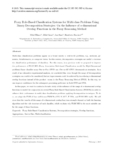Mostrar el registro sencillo del ítem
Fuzzy rule-based classification systems for multi-class problems using binary decomposition strategies: on the influence of n-dimensional overlap functions in the fuzzy reasoning method
| dc.creator | Elkano Ilintxeta, Mikel | es_ES |
| dc.creator | Galar Idoate, Mikel | es_ES |
| dc.creator | Sanz Delgado, José Antonio | es_ES |
| dc.creator | Bustince Sola, Humberto | es_ES |
| dc.date.accessioned | 2017-02-01T10:22:23Z | |
| dc.date.available | 2018-03-01T00:00:15Z | |
| dc.date.issued | 2016 | |
| dc.identifier.issn | 0020-0255 (Print) | |
| dc.identifier.issn | 1872-6291 (Electronic) | |
| dc.identifier.uri | https://hdl.handle.net/2454/23450 | |
| dc.description.abstract | Multi-class classification problems appear in a broad variety of real-world problems, e.g., medicine, genomics, bioinformatics, or computer vision. In this context, decomposition strategies are useful to increase the classification performance of classifiers. For this reason, in a previous work we proposed to improve the performance of FARC-HD (Fuzzy Association Rule-based Classification model for High-Dimensional problems) fuzzy classifier using One-vs-One (OVO) and One-vs-All (OVA) decomposition strategies. As a result of an exhaustive experimental analysis, we concluded that even though the usage of decomposition strategies was worth to be considered, further improvements could be achieved by introducing n-dimensional overlap functions instead of the product t-norm in the Fuzzy Reasoning Method (FRM). In this way, we can improve confidences for the subsequent processing performed in both OVO and OVA. In this paper, we want to conduct a broader study of the influence of the usage of n-dimensional overlap functions to model the conjunction in several Fuzzy Rule-Based Classification Systems (FRBCSs) in order to enhance their performance in multi-class classification problems applying decomposition techniques. To do so, we adapt the FRM of four well-known FRBCSs (CHI, SLAVE, FURIA, and FARC-HD itself). We will show that the benefits of the usage of n-dimensional overlap functions strongly depend on both the learning algorithm and the rule structure of each classifier, which explains why FARC-HD is the most suitable one for the usage of these functions. | en |
| dc.description.sponsorship | This work has been supported by the Spanish Ministry of Science and Technology under the project TIN-2013-40765-P. | en |
| dc.format.mimetype | application/pdf | en |
| dc.language.iso | eng | en |
| dc.publisher | Elsevier | en |
| dc.relation.ispartof | Information Sciences 332 (2016) 94–114 | en |
| dc.rights | © 2015 Elsevier Inc. The manuscript version is made available under the CC BY-NC-ND 4.0 license. | en |
| dc.rights.uri | https://creativecommons.org/licenses/by-nc-nd/4.0/ | |
| dc.subject | Fuzzy rule-based classification systems | en |
| dc.subject | Decomposition strategies | en |
| dc.subject | Overlap functions | en |
| dc.subject | Aggregations | en |
| dc.subject | One-vs-one | en |
| dc.subject | One-vs-all | en |
| dc.subject | Multi-classification | en |
| dc.title | Fuzzy rule-based classification systems for multi-class problems using binary decomposition strategies: on the influence of n-dimensional overlap functions in the fuzzy reasoning method | en |
| dc.type | Artículo / Artikulua | es |
| dc.type | info:eu-repo/semantics/article | en |
| dc.contributor.department | Automática y Computación | es_ES |
| dc.contributor.department | Automatika eta Konputazioa | eu |
| dc.contributor.department | Institute of Smart Cities - ISC | es_ES |
| dc.rights.accessRights | Acceso abierto / Sarbide irekia | es |
| dc.rights.accessRights | info:eu-repo/semantics/openAccess | en |
| dc.embargo.terms | 2018-03-01 | |
| dc.identifier.doi | 10.1016/j.ins.2015.11.006 | |
| dc.relation.projectID | info:eu-repo/grantAgreement/MINECO//TIN2013-40765-P/ES/ | en |
| dc.relation.publisherversion | https://dx.doi.org/10.1016/j.ins.2015.11.006 | |
| dc.type.version | Versión aceptada / Onetsi den bertsioa | es |
| dc.type.version | info:eu-repo/semantics/acceptedVersion | en |



